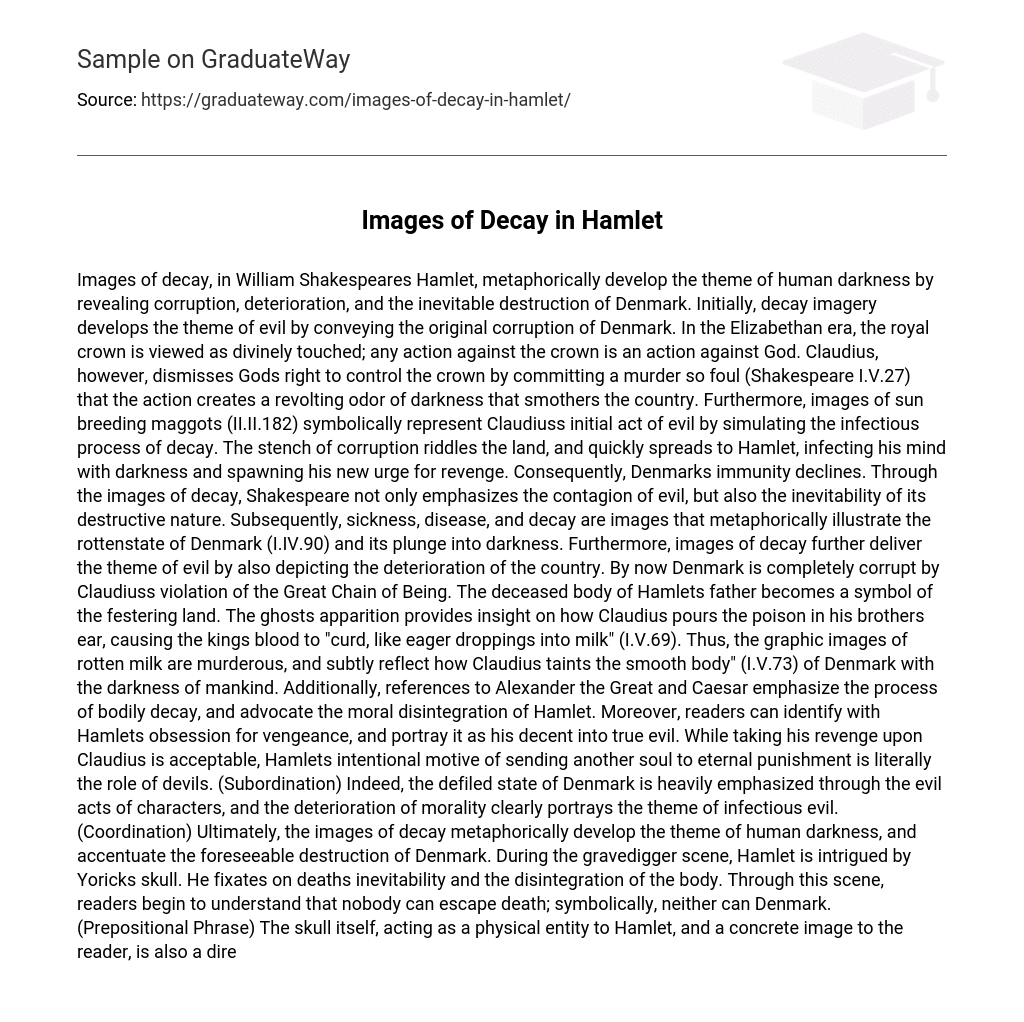Images of decay, in William Shakespeares Hamlet, metaphorically develop the theme of human darkness by revealing corruption, deterioration, and the inevitable destruction of Denmark. Initially, decay imagery develops the theme of evil by conveying the original corruption of Denmark. In the Elizabethan era, the royal crown is viewed as divinely touched; any action against the crown is an action against God. Claudius, however, dismisses Gods right to control the crown by committing a murder so foul (Shakespeare I.V.27) that the action creates a revolting odor of darkness that smothers the country. Furthermore, images of sun breeding maggots (II.II.182) symbolically represent Claudiuss initial act of evil by simulating the infectious process of decay.
The stench of corruption riddles the land, and quickly spreads to Hamlet, infecting his mind with darkness and spawning his new urge for revenge. Consequently, Denmarks immunity declines. Through the images of decay, Shakespeare not only emphasizes the contagion of evil, but also the inevitability of its destructive nature. Subsequently, sickness, disease, and decay are images that metaphorically illustrate the rottenstate of Denmark (I.IV.90) and its plunge into darkness.
Furthermore, images of decay further deliver the theme of evil by also depicting the deterioration of the country. By now Denmark is completely corrupt by Claudiuss violation of the Great Chain of Being. The deceased body of Hamlets father becomes a symbol of the festering land. The ghosts apparition provides insight on how Claudius pours the poison in his brothers ear, causing the kings blood to “curd, like eager droppings into milk” (I.V.69). Thus, the graphic images of rotten milk are murderous, and subtly reflect how Claudius taints the smooth body” (I.V.73) of Denmark with the darkness of mankind.
Additionally, references to Alexander the Great and Caesar emphasize the process of bodily decay, and advocate the moral disintegration of Hamlet. Moreover, readers can identify with Hamlets obsession for vengeance, and portray it as his decent into true evil. While taking his revenge upon Claudius is acceptable, Hamlets intentional motive of sending another soul to eternal punishment is literally the role of devils. (Subordination) Indeed, the defiled state of Denmark is heavily emphasized through the evil acts of characters, and the deterioration of morality clearly portrays the theme of infectious evil. (Coordination) Ultimately, the images of decay metaphorically develop the theme of human darkness, and accentuate the foreseeable destruction of Denmark.
During the gravedigger scene, Hamlet is intrigued by Yoricks skull. He fixates on deaths inevitability and the disintegration of the body. Through this scene, readers begin to understand that nobody can escape death; symbolically, neither can Denmark. (Prepositional Phrase) The skull itself, acting as a physical entity to Hamlet, and a concrete image to the reader, is also a direct representation of despair. Not only does the skull provide reminiscence of Denmark before Claudiuss rule, but it also emphasizes the contrast between light and darkness.
The human darkness that festers the land overshadows the joyful times of Yorick. Thus, the comparison between two distinctive time periods, one of good and one of evil, foreshadows the regression of Denmark into its fated devastation. In conclusion, images of decay convey the theme of human darkness, and its nature of corrupting, deteriorating, and ultimately destroying the once wholesome state of Denmark.
Works Citied
- Shakespeare, William. Hamlet. Toronto: Canadian School Book Exchange, 1996.





